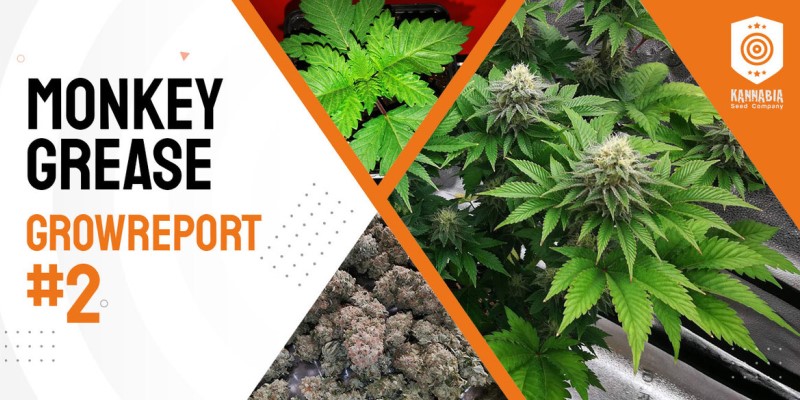
Grow Report – Monkey Grease
With a taste profile as unique as her name, Monkey Grease is a hybrid that delivers a completely new sensory experience even for those cannabis enthusiasts who have seen it all. This THC-laden variety could…
Iberian Peninsula express shipping
0€ Orders over 60€
*6€ orders under 59€
East, West, South Europe express shipping
0€ Orders over 150€
*18€ orders under 149€
North Europe express shipping
0€ Orders over 160€
*20€ orders under 159€
Ireland, Norway, UK normal shipping
0€ Orders over 60€
*6€ orders under 59€
Rest of the world normal shipping
0€ Orders over 180€
*25€ orders under 179€
Shipping costs can be confirmed in your shopping cart.
For additional shipping methods, please reach out through info@kannabia.com.


*Website protected by SSL.
**Not available in all regions.
*Your coupon will be sent via email.
*Should you have any question, comment or feedback, please do not hesitate to contact us.

When planning a grow, it’s important to know its purpose. Knowing the sex of your marijuana plants is vital so that you don’t end up wasting any time or resources. Here we explain everything you need to know about male cannabis plants and their uses.
Marijuana is a dioecious plant species. This means that it reproduces when a male and a female plant cross through pollination. However, most cannabis seeds currently on the market are feminised, because growers prefer to have a guaranteed 100% rate of female descendants that produce seedless cannabis flowers, i.e. buds loaded with cannabinoids and terpenes.
But before feminised seeds broke into the market, cannabis growers used to use regular seeds, which produce both male and female cannabis specimens at a ratio of around 50% each. Therefore, the male cannabis plants produce male flowers that release pollen with which the female flowers are pollinated, thereby producing seeds to continue the species.
Old-school growers who had no option but to use regular seeds, needed to watch for male plants and remove them from their grows, because it isn’t pleasant to smoke buds with seeds. Besides, the female plants would otherwise focus their energy on producing those seeds rather than on producing more flowers and trichomes, which would translate into a much lower potency.
The only way to guarantee that a seed will turn into a female plant is by using feminised seeds. These are aimed at fully eliminating the possibility of male plants developing. This means that growers no longer have to discard male plants, which saves both time and resources that would otherwise be used to look after those potentially unwanted plants.
If you use regular seeds, cannabis plants won’t show their sex during the vegetative phase: it is only at the start of the flowering period that this can be clearly identified. This phase, known as the ‘pre-flowering’, starts in nature when days become shorter, which therefore results in a change in the photoperiod.
It is at that point that you need to be really attentive: the part of the plant that you need to keep an eye on is what is commonly known as ‘axilla’, which is the union between the main stem and the branches. It is right there, on the underside, that you’ll see the flower primordia (or pre-flowers) forming, i.e. the little buds from which flowers will develop:
Therefore, the key to figuring out if a marijuana plant is male or female lies in keeping an eye out for the formation of any stigmas (or little hairs). Later on, during the flowering phase, male flowers open, showing an internal structure that resembles a small bunch of bananas. These are the stamens which will eventually spread their pollen to fertilise the female flowers.
On the other hand, female cannabis plants, after showing their female sex with the first stigmas, will generate clusters of these flowers with more ‘little hairs’ that will then start to get covered in resin glands (trichomes). This continues until they finally accumulate in the form of buds which can sometimes reach incredible dimensions.
Although the appearance of male cannabis plants in their crops can be unwelcome news for some growers, it is important to remember that males have multiple applications and can therefore be very useful too:
The perfect cutting time for your male plants will depend on the purpose of your cannabis crop and, therefore, the final use for the plants. If you want to harvest seedless buds, the answer is clear: cut as soon as you can identify their sex. Remember that you can identify the males long before their flowers ripen, which is when they pose a real risk for your precious harvest.
However, if you’re looking to cross your favourite phenos, you must wait until pollination is completed before cutting the males. This can be immediately after the females have been pollinated, or you can always wait a few more days if you want to do a second pollination round with the pollen from the flowers that still haven’t fully ripened.
Ultimately, male marijuana plants are a potential threat to your crop if you’re mainly after consumable buds; but they can also be a great ally if your objective is the hybridisation and breeding of new strains. So now that you’ve learnt more about their characteristics and applications, you’ll know what to do if you come across one of them.